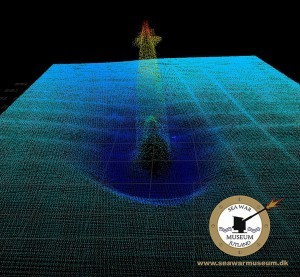A missing German submarine said to have taken the defeated Nazi leadership to South America has been discovered after being lost at sea for nearly 73 years.
The U-3523 was one of Hitler’s Type XXI submarines – a new and highly advanced design which came too late to stop an allied victory.
It was the first class of U-boats designed to sail submerged for a prolonged period of time and had a range which allowed it to sail non-stop to South America.
The U-3523 was thought to have been sunk by a British B24 Liberator attack on May 6, 1945, but the inability to locate the wreck fuelled rumors that it had escaped.
Now the wreck has been located ten nautical miles north of Skagen – Denmark’s northernmost town – and nine miles west of the position reported by the British bomber.
Denmark’s Sea War Museum, which found the submarine, said there was no evidence that it was escaping with Nazi leaders or loot.
Gert Normann Andersen, the museum’s director, said: “Rumor has it that the submarine had great valuables from Germany because it was heading away from Germany even though the war ended.”
“I think the rumor developed because U-3523 was a very modern, long-distance U-boat and some Nazis tried to escape with valuables in the last days.”
“But the submarine was going to Norway, and not to South America with Nazis and valuables.”
Declassified documents from US intelligence have fuelled claims that the Nazi leadership, including Adolf Hitler himself, escaped to South America in the final days of the war.
One CIA file dated October 3, 1955, carried allegations from a former SS trooper named Phillip Citroen that Hitler had been hiding in Colombia and later Argentina.
The trooper even had a photo taken in 1954 in the Colombian city of Tunja, allegedly showing him with a man said to be Hitler.
The document stated: “According to Citroen, the Germans residing in Tunja followed this alleged Adolf Hitler with an idolatry of the Nazi past, addressing him as ‘der Fuhrer’ and affording him the Nazi salute and storm-trooper adulation.”
Meanwhile a file from the FBI archives, dated September 21, 1945, detailed eyewitness claims that Hitler had arrived in Argentina via a submarine two-and-a-half weeks after the fall of Berlin.
It said: “By pre-arranged plan with six top Argentine officials, pack horses were waiting for the group and by daylight all supplies were loaded on the horses and an all-day trip inland toward the foothills of the southern Andes was started.”
“At dusk the party arrived at the ranch where Hitler and his party, according to (redacted), are now in hiding.”
Several prominent Nazis are also known to have fled to South America, including Adolf Eichmann – a leading architect of the Holocaust, and the notorious Auschwitz doctor Josef Mengele.
However, the new discovery proves that U-3523 never made the trip and sank with all 58 crewmen.
Andersen also has a copy of the last telegram sent by the submarine, dated May 5, 1945, which makes no mention of any precious cargo or high-ranking passengers.
Nazi Germany would sign the first instrument of unconditional surrender just two days later on May 7, 1945.
Scans of the seabed reveal the U-boat now lies in 403 feet of water, making it very difficult to access.
Unusually, the whole fore of the ship lies buried in the sand, while the stern stands 65 feet above the bottom.
Nazi Germany built 118 Type XXI U-boats but – due to poor quality control – only four were fit for combat before World War II ended and just two were deployed, neither sinking any allied ships.
Their design was later copied by Britain, the US, France and the Soviet Union with Soviet models subsequently inspiring Chinese submarines.
Only one original Type XXI U-boat survives, the Wilhelm Bauer (formerly U-2540), which is now part of the German Maritime Museum in Bremerhaven.
Source: nypost
Ask me anything
Explore related questions









